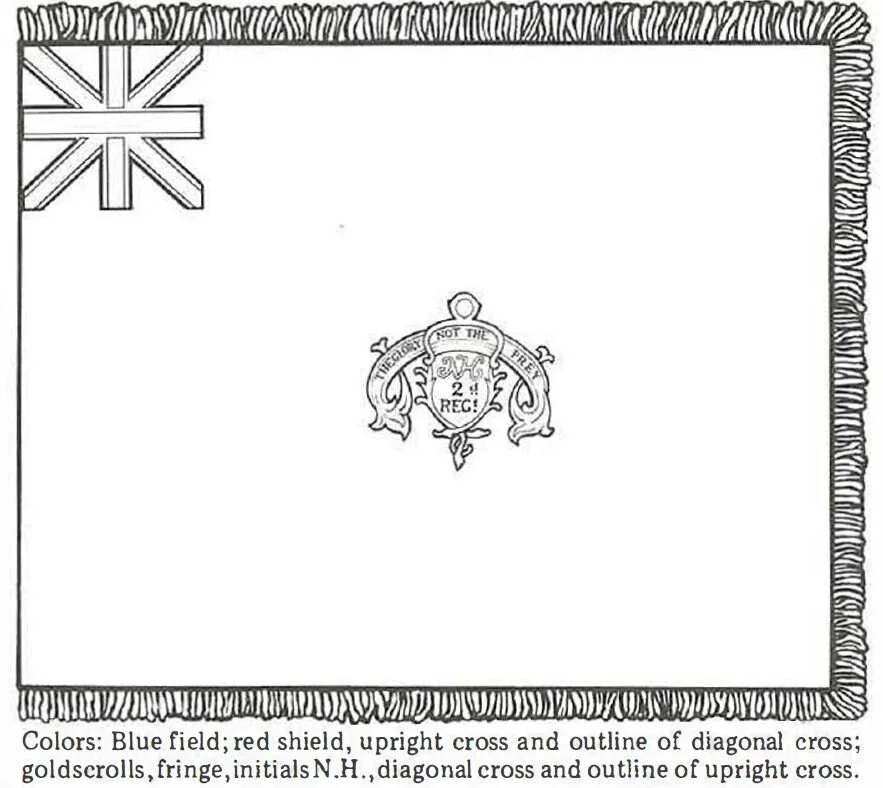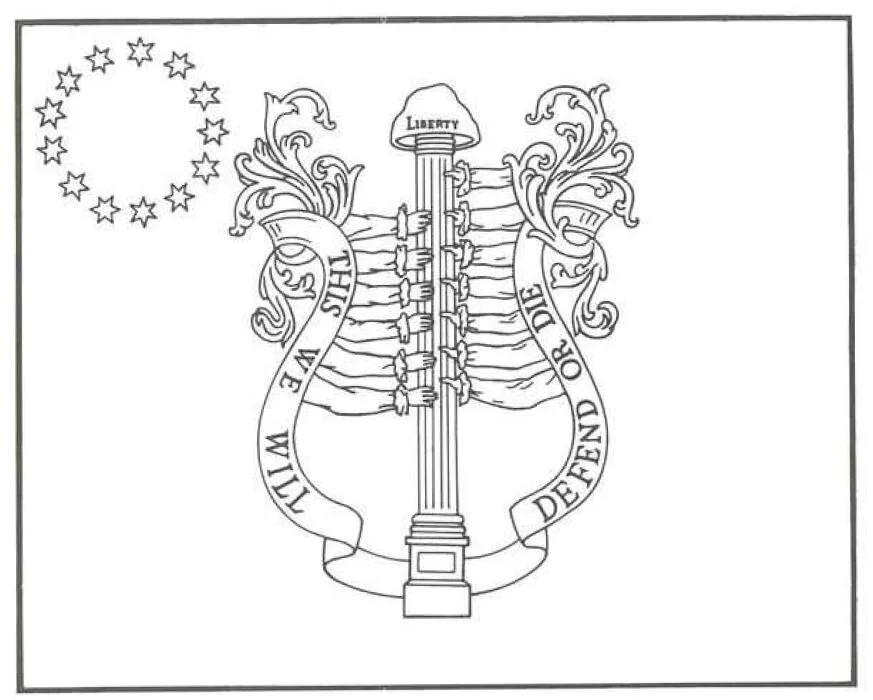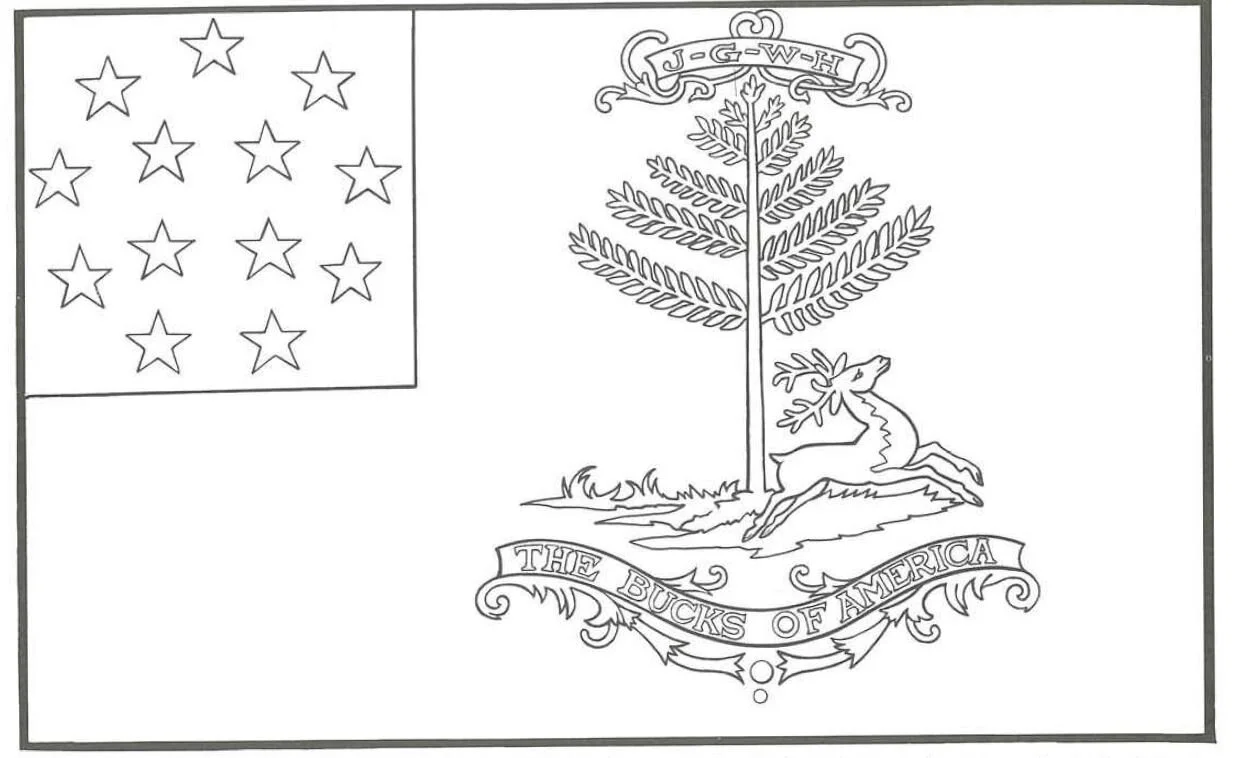-By "Flintlock" Larrabee
FLAGS OF THE SECOND NEW HAMPSHIRE REGIMENT, CONTINENTAL LINE
These two flags of the Second New Hampshire Regiment are among the few American flags in existence that were captured during the Revolutionary War. They were lost July 8, 1777, to the British near Fort Anne, New York, when ammunition ran out after a brave defense in which the Ninth British Regiment of Foot were themselves nearly captured. The Americans retreated to General Schuyler's headquarters at Fort Edward, but Lt. Colonel Hill, the English commander, ended up with their flags and took them to England. They remained
there with his descendants until 1912, when they were bought and presented to the New Hampshire Historical Society.
Colors: Buff field, golden disk, rays and interlaced rings; red and blue alternating triangles beginning with red at the
upper left.
There is scarcely a more fitting way of celebrating Flag Day, June 14th, the anniversary of the adoption of the "rebellious stripes" by the Continental Congress, in this bicentennial year than by creating copies of those Revolutionary banners that were carried by the Heroes of '76, flying them at the head of your parading NMLRA re-created Militia or Continental army unit.
With the kind permission of Bellorophon Books, 133 Steuart Street, San Francisco, Ca. 94105, we have reproduced here a few representative flags, with accompanying specifics of colors and origins, from their excellent Flags of the American Revolution to Color.
Of particular interest are the flags of the 2nd New Hampshire Regiment, captured and taken to England, since they are surviving examples of perhaps more typical Continental flags. In 1776 and afterward the Union Jack cantons would have been replaced with thirteen stars or thirteen stripes (though the 2nd New Hampshire hadn't gotten around to this when it lost its colors in 1777) as in the case of the Headman Flag.
The design of the Headman Flag is especially useful, since the unit it represented is unknown, and therefore, if research fails to uncover a design used by a regiment from your own area, you can always use the Headman design, since, though the chances that it was from your area are extremely slim, it is an AUTHENTIC design, and therefore more genuinely representative of the Continental army than a design your flag committee has concocted up out of supposition and conjecture.
On the other hand, however, the members of your club might be pleased with a design akin to the Bucks of America banner, as there is probably not a NMLRA member alive who doesn't consider himself or herself an ardent conservationist, and the Bucks flag with its Liberty Tree and bounding stag neatly combines patriotic feeling with our interest in prese1·ving the wildernesses of the country itself. The name of your club or re-created unit can be substituted for the "Bucks of America" legend in the bannerscroll. The pine ( ?) tree might be replaced with a palmetto tree in the case of a South Carolina or Florida club, a yellow (longleaf) pine in the instance of clubs in other southern states, and a maple, white pine, or fir in the case of northern states.
In painting the design of your flag (for some of the designs are so intricate it would take a seamstress too long to complete them by embroidery), it is not necessary to paint them on silk, as requested by Henry Marchant*. Good quality cotton will suffice, though the paint should be quick-drying, water
proof acrylic paint.
The flags shown here are only a few of the forty-one designs contained in the Bellerophon coloring book, a bargain costing only $1.00. •
*Writing to John Hancock on November 16, 1774, to have the flag of the Newport, Rhode Island, Light Infantry Company made up, he requested " ... their Colom·s should be made of the neatest, best Silk ... "
Colors: Blue field; red shield, upright cross and outline of diagonal cross; gold scrolls, fringe, initialsN.H.,diagonal cross and outline of upright cross.
This company was formed in the fall of 1774 to improve upon "the low State of Military Discipline" in Rhode Island.
THE HEADMAN FLAG
Colors: Green field, gold stars (which are in a conjectural arrangement),
scrolls, arms, column and Liberty Hat. This flag, belonging to the Smithsonian Museum of History and Technology in Washington, D.C., descended through the family of Sergeant Headman, probably from Pennsylvania. It was listed in New Standards and Division Colors, published in 1778, but we do not know what regiments received the colors.
BUCKS OF AMERICA Colors: Buff field, letters; white stars; blue canton, scrolls, flourishes; green leaves, grass; brown buck, trunk. John Hancock, Governor of Massachusetts, presented this flag after the war to a company of black soldiers for valor. We know little about the Bucks of America; they were among the thousands of black Revolutionary patriots.





